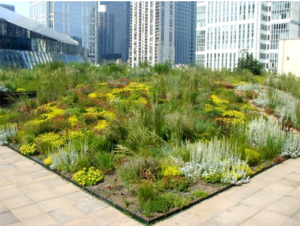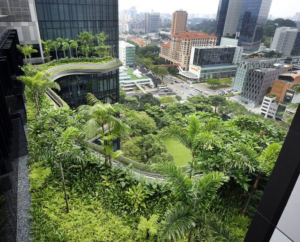Ishah
Chicago, IL
City Hall’s Rooftop Garden
 Not a commune per se, but a green urban utopia much like New York’s Central Park. However, Chicago’s rooftop garden is not open to the public, and when searched on Google, it is listed as permanently closed. Chicago is a well-known concrete jungle, and this 20,300 square-foot garden has an important environmental role for the city of Chicago. The garden was the proposed solution to an EPA study to combat the urban heat island effect. According to the EPA, the term “‘heat island’ describes built up areas that are hotter than nearby rural areas…[with] the annual mean air temperature of a city with 1 million people or more can be 1.8˚-5.4˚ F warmer than its surroundings…in the evening, the difference can be as high as 22˚F. Heat islands can affect communities by increasing summertime peak energy demand, air conditioning cost, air pollution and greenhouse gas emissions, heat-related illness & mortality, and water quality.” [1]
Not a commune per se, but a green urban utopia much like New York’s Central Park. However, Chicago’s rooftop garden is not open to the public, and when searched on Google, it is listed as permanently closed. Chicago is a well-known concrete jungle, and this 20,300 square-foot garden has an important environmental role for the city of Chicago. The garden was the proposed solution to an EPA study to combat the urban heat island effect. According to the EPA, the term “‘heat island’ describes built up areas that are hotter than nearby rural areas…[with] the annual mean air temperature of a city with 1 million people or more can be 1.8˚-5.4˚ F warmer than its surroundings…in the evening, the difference can be as high as 22˚F. Heat islands can affect communities by increasing summertime peak energy demand, air conditioning cost, air pollution and greenhouse gas emissions, heat-related illness & mortality, and water quality.” [1]
The garden is owned by Chicago’s Department of Environment and contains over 20,000  herbaceous plants. It was completed in 2001 after an initial failed attempt at a rooftop garden in 1991. The garden $1.1 billion garden is part of Chicago mayor Richard Daley’s campaign promise to make Chicago “the greenest city in America.”[2]
herbaceous plants. It was completed in 2001 after an initial failed attempt at a rooftop garden in 1991. The garden $1.1 billion garden is part of Chicago mayor Richard Daley’s campaign promise to make Chicago “the greenest city in America.”[2]
The choice of plants depends heavily on the depths of soil they have in each section of the garden. Soil depths range from 4-18 inches and the plants serve a structural purpose of slowing down rainwater runoff.[3]
From an aerial view, the garden doesn’t look like much: it is clearly man-made and meant to conform to the limited space of the rooftop of the city hall building. It is mostly green with dots of color from different plant species. Up close, it is quite beautiful. The garden is lush and well-taken care of, with each plant adding unique charm to this garden. Albeit its purpose is for urban environmental research, the small burst of green is a pleasant sight in a city that is mostly brown and grey.

Small green spaces like Chicago’s garden are instrumental to big cities; especially during today’s rapid increase in global temperature and the looming threats of climate change on the physical environment, this garden is a reclamation and a realization of the importance of a mutually beneficial relationship between large cities and natural spaces. It is doubtful that Chicago has any land area to make their garden a full-fledged park, but this small garden helps the city as a whole, saving, it more the $5000 annually in utility costs.
 Rooftop gardens have been recreated in many cities around the world from Manhattan to Tokyo that serve both environmental and aesthetic purposes. Rooftop gardens are primarily found in heavily urban areas, and serve the purpose of reducing urban heat islands. In a city with limited natural land area, rooftop gardens can serve important urban agricultural purposes as well as several environmental benefits like decreasing rainwater runoff. Singapore is the leading country that utilizes rooftop gardens for recreational, leisure, and environmental purposes.
Rooftop gardens have been recreated in many cities around the world from Manhattan to Tokyo that serve both environmental and aesthetic purposes. Rooftop gardens are primarily found in heavily urban areas, and serve the purpose of reducing urban heat islands. In a city with limited natural land area, rooftop gardens can serve important urban agricultural purposes as well as several environmental benefits like decreasing rainwater runoff. Singapore is the leading country that utilizes rooftop gardens for recreational, leisure, and environmental purposes.
Recently, heavily urban cities have been trying to implement rooftop gardens as an integral part of urban planning.